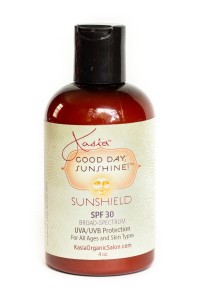New research is revealing connections between vitamin D deficiency and a myriad of health concerns, including cancer, depression, osteoporosis, immune dysfunction, diabetes, heart disease, and more. Vitamin D controls many processes within our biological makeup.
Our company is passionate about integrating women's health essentials with our products and services. So much so we've FORTIFIED it into our CERTIFIED ORGANIC GOOD DAY SUNSHINE BODY and TINTED FACE SUNBLOCK. That's right - you will get 400 IU of the most available form of vitamin D3 with your morning slather! Note: Our sunscreen is now available in a neutral tint that blends perfectly (non-greasy) with your skin's natural pigments - leaving out the classic white out from zinc.
"D" No Matter What!
Our Certified Organic Sunblock supports intake of Vitamin D while diminishing the percentage of dermal aging and skin cancer.
GOOD DAY SUNSHINE Organic Anti-Aging Mineral Sunblock SPF 35 with Vitamin D
-
Vegan, certified organic, edible ingredients
-
SPF 35 provides 97% broad spectrum UVA/UVB protection

-
Contains non-nano, non-micronized zinc oxide, the safest and most effective sunblock available
-
Rich in powerful antioxidants and polyphenols that boost sun protection and combat signs of aging
-
Reduces blemishes and blends sunspots
-
Transparent, lightweight consistency
-
Fortified with 400 IU vitamin D3
-
Baby and kid safe
Enjoy the following article by Rhonda P Ph.D and Wellness FX.
Vitamin D, a fat-soluble vitamin many of you have heard of, is actually a steroid hormone that controls the expression of over 1,000 genes in the body.1 This means that vitamin D is controlling over 1,000 different physiological processes. Today we are going to dive into how this hormone actually plays an important role in the aging process.
The basics: Where can we get vitamin D and how much is enough? The primary source of vitamin D is UVB irradiation from the sun.1 Our skin can produce vitamin D upon exposure to the sun, usually 15 minutes a day is adequate.1
There are a few factors that affect the ability of our body to produce vitamin D:
-
Sunscreen – UVB radiation must not be filtered out in order to elicit vitamin D synthesis. Since most sunscreens block UVB irradiation, they also block the ability of our skin to synthesize vitamin D from the sun.1
-
Skin pigmentation – Melanin, the pigment found in skin, is an adaptation that serves as a natural sunscreen, so darker skin color also blunts the body’s ability to make vitamin D.1
-
Age – As we age our body becomes less efficient at producing vitamin D from sun exposure.2 In fact,a 70-year-old makes 4 times less vitamin D from the sun than a 20-year-old.2
-
Body fat – Since vitamin D is fat soluble, the higher the body fat, the lower the bioavailability. A higher concentration of body fat prevents the vitamin D from being released into the blood stream. In fact, obese individuals have 50% less bioavailability of vitamin D compared to non-obese individuals.3
The fact that vitamin D is fat soluble belies the very reason why it is important to get the dosage right: it can build up in your fatty tissues, unlike, for example, vitamin C which is water soluble.
The “sweet spot”: The right serum level for vitamin D
A wide range for “optimal” levels of vitamin D can be found in scientific literature and is often reported as serum levels between 30-80 ng/ml.4
Vitamin D insufficiency is often reported as <30 ng/ml and deficiency as <20 ng/ml.5 The Center for Disease Control and Prevention (CDC) has reported that approximately 30% of light-skinned Americans have sufficient vitamin D levels (defined as 30 ng/ml) and only 5% of African Americans have sufficient levels.4In developed nations a major cause of this “pandemic” is this: people spending more time indoors on computers and then wearing sunscreen during the otherwise brief intervals of time that they spend outdoors.
As far as supplementation goes, the National Institute of Medicine (NIM) recommends the tolerable upper intake for adults at 4,000 IU.5 Since vitamin D is fat-soluble, it can be toxic at high doses. Data compiled from several different vitamin D supplementation studies reveal that vitamin D toxicity is usually obtained at doses higher than 10,000 IU for adults.6
What are the easiest ways to increase my vitamin D?
Dietary sources are the best option, since this entirely circumvents two of the four aforementioned challenges with skin synthesis. Among the dietary sources, fish is the richest source of vitamin D:1
-
salmon 530 IU per 3.5 ounces
-
sardines 231 IU per 3.5ounces
-
mackerel 213 IU per 3.5 ounces
-
cod oil 400 IU per teaspoon
Mushrooms are also high in vitamin D, especially if they have been in contact with UVB radiation.7 Foods that are often artificially enriched with vitamin D include the following: whole milk (100IU per 8 oz), orange juice (100IU per 8 oz), some cereals, and some yogurts.8 However, to obtain adequate levels of vitamin D from fortified foods you would have to consume extremely large amounts of these foods.9
Telomeres: A biomarker of age
Telomeres are caps at the end of your chromosomes that protect your DNA from damage. You can think of telomeres sort of like the tips of shoelaces that protect them from fraying. Telomeres get shorter with each cell division until there is nothing left and your cells die or undergo a permanent arrest, called senescence. Some of our cells have a special enzyme, called telomerase, that allows our telomeres to be rebuilt—but only certain cells have this enzyme. 10 For this reason, telomere length has been used as a biological marker of age, the younger you are the longer your telomere length. There are certain factors that can either accelerate or delay the attrition of your telomeres.
Vitamin D and its role in telomere length
A large epidemiological study consisting of 2,100 female twin pairs found that increased vitamin D levels correlated with increased telomere length in white blood cells (WBCs).10 Here’s the real kicker: the difference in telomere length between those with high (vitamin D sufficient) versus low (vitamin D insufficient) levels of vitamin D corresponded to 5 years of aging.10 The study also found that the participants that regularly supplemented vitamin D also had longer telomeres than those not taking supplements.10 Another study that included both males and females, again found that higher plasma vitamin D was significantly associated with longer telomere length in WBCs.11
Some of the mechanisms by which vitamin D is thought to delay the shortening of telomeres is by decreasing inflammation and cell proliferation, both of which accelerate telomere shortening12.
For completeness I’d like to now give a brief summary of some of the things that are known to effect telomere length (and by implication, aging).
Factors that hasten telomere shortening:12
-
Chronic stress
-
Alcohol
-
Smoking
-
Inflammation
-
Obesity
-
Oxidative Stress
Factors that extend telomere length:16
-
Vitamin D sufficiency
-
Omega-3 sufficiency
-
Folic acid sufficiency
-
Meditaton
-
Exercise


